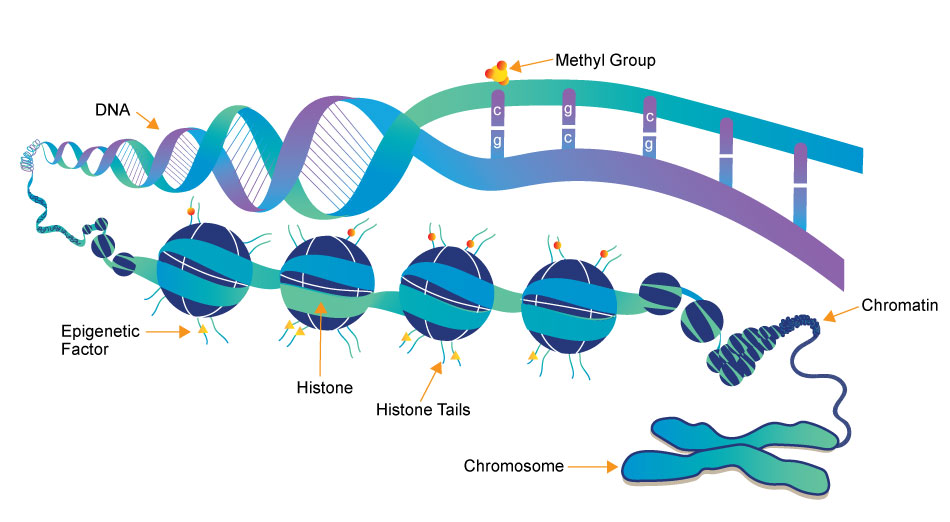Epigenetics


Epigenetics research delves into the molecular mechanisms that control gene expression and cellular traits without altering the underlying DNA sequence. One crucial aspect of this field is the role of small molecules, which act as powerful regulators of epigenetic modifications. These small compounds, typically comprising a few dozen to a few hundred atoms, have emerged as essential tools in understanding and manipulating the epigenome.
- DNA Methylation Inhibitors: Small molecules like 5-azacytidine and 5-aza-2'-deoxycytidine are DNA methyltransferase inhibitors. They block the addition of methyl groups to DNA, leading to DNA demethylation. This can reactivate silenced genes, potentially offering therapeutic avenues for conditions like cancer.
- HDAC inhibitors: HDACs remove acetyl groups from histone proteins, contributing to gene repression. Small molecule HDAC inhibitors, such as Vorinostat and Romidepsin, can reverse this process by increasing histone acetylation, allowing genes to be more accessible for transcription. These inhibitors are being explored for cancer therapy and other conditions.
- Histone Methyltransferase Inhibitors: Small molecules like GSK126 inhibit specific histone methyltransferases, affecting histone methylation patterns. This can alter gene expression, making them promising candidates for cancer and other diseases with epigenetic dysregulation.
- RNA Modulators: Small molecules can also target non-coding RNAs involved in epigenetic regulation. For instance, small molecules called small interfering RNAs (siRNAs) can be designed to target and degrade specific long non-coding RNAs, influencing gene expression.
- Epigenetic Reader Domain Inhibitors: These small molecules target proteins that recognize and bind to specific epigenetic marks. Examples include inhibitors of bromodomain-containing proteins (BET inhibitors), which can disrupt gene regulation by interfering with protein-DNA interactions.
Small molecules in epigenetics research not only provide insights into the fundamental biology of gene regulation but also hold immense promise for developing novel therapeutics. Their ability to selectively modulate specific epigenetic marks and pathways has led to ongoing clinical trials and drug development efforts for various diseases, including cancer, neurological disorders, and inflammatory conditions. Understanding and harnessing the power of these small molecules is at the forefront of modern epigenetics research, offering new hope for precision medicine and targeted therapies.
3 key components involved in the regulation of epigenetic modifications
Epigenetics Writer
Epigenetics writers are enzymes responsible for adding chemical marks or modifications to DNA or histone proteins. These marks include DNA methylation (addition of methyl groups to DNA) and histone modifications (such as acetylation, methylation, phosphorylation, etc.).
Epigenetics Reader
Function: Epigenetics readers are proteins that can recognize and bind to specific epigenetic marks on DNA or histones. These reader proteins interpret the epigenetic code and facilitate downstream cellular processes, such as gene activation or repression.
Epigenetics Eraser
Function: Epigenetics erasers are enzymes responsible for removing or reversing epigenetic marks on DNA or histones. This process allows for the dynamic regulation of gene expression and the resetting of epigenetic states during various stages of development and in response to environmental changes.
-
Lin28-let-7a 拮抗剂
Lin28-let-7a antagonist 1 对 Lin28-let-7a 之间的相互作用表现出明显的拮抗效果,其 IC50 值为4.03 μM,针对 Lin28A-let-7a-1 的相互作用。 -
human A3 adenosine receptor 拮抗剂 /Aurora 抑制剂
Reversine 是一种强效的人类 A3 腺苷受体拮抗剂,其 Ki 值为 0.66 μM,同时也是一种全泛 Aurora A/B/C 激酶抑制剂,其 IC50 分别为 12 nM、13 nM 和 20 nM。此外,Reversine 还用于干细胞去分化。- Amy H. Ide, .et al. , Mol Biol Cell, 2023, Jun 1;34(7):ar76 PMID: 37126397
- Hazheen K, .et al. , J Biol Chem, 2020, August 20
-
CBP/beta-catenin 拮抗剂
PRI-724 是第二代、强效且特异性的 CBP/β-连环蛋白复合体抑制剂,以及癌症干细胞中 β-连环蛋白依赖的经典 Wnt 信号通路的调节剂。- Paul Mark Medina, .et al. , Transl Oncol, 2021, Jan;14(1):100940 PMID: 33221682
-
WDR5 拮抗剂
WDR5-0103 是一种小分子,能够结合到 WDR5 上的肽结合口袋(Kd = 450 nM),在体外抑制 MLL 核心复合体的催化活性(IC50 = 39 M)。- Nicolas A Fraunhoffer, .et al. , EBioMedicine, 2023, Jun;92:104602 PMID: 37148583




